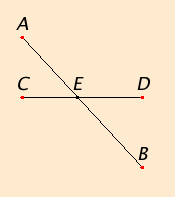Proposition 15
Let the straight lines AB and CD cut one another at the point E.
I say that the angle CEA equals the angle DEB, and the angle BEC equals the angle AED.

Since the straight line AE stands on the straight line CD making the angles CEA and AED, therefore the sum of the angles CEA and AED equals two right angles.
Again, since the straight line DE stands on the straight line AB making the angles AED and DEB, therefore the sum of the angles AED and DEB equals two right angles.
But the sum of the angles CEA and AED was also proved equal to two right angles, therefore the sum of the angles CEA and AED equals the sum of the angles AED and DEB. Subtract the angle AED from each. Then the remaining angle CEA equals the remaining angle DEB.
Similarly it can be proved that the angles BEC and AED are also equal.
Therefore if two straight lines cut one another, then they make the vertical angles equal to one another.